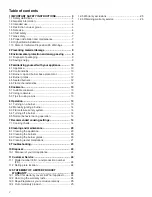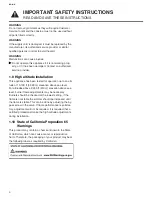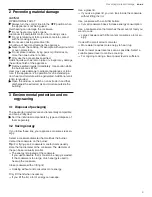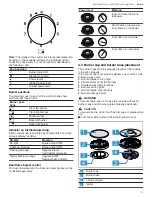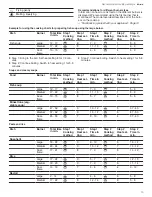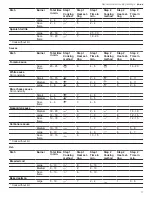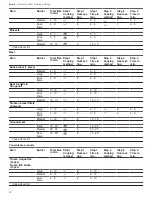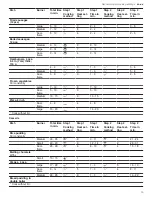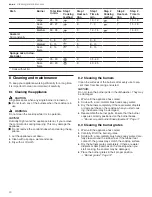
en-us
5
▶
Have an appropriate fire extinguisher available, nearby,
highly visible and easily accessible near the appliance.
If the cooktop is near a window, forced air vent or fan, be
certain that flammable materials such as window cover-
ings do not blow over or near the burners or heating ele-
ments. They could catch on fire.
Cooking fires can spread if extinguished incorrectly.
▶
Never use water on cooking fires.
WARNING - TO REDUCE THE RISK OF A GREASE
FIRE
▶
Never Leave Surface Units Unattended at High Set-
tings - Boilovers cause smoking and greasy spillovers
that may ignite. Heat oils slowly on low or medium set-
tings.
▶
Always turn hood ON when cooking at high heat or
when flambeing food (i.e. Crepes Suzette, Cherries Ju-
bilee, Peppercorn Beef Flambe’).
▶
Clean ventilating fans frequently. Grease should not be
allowed to accumulate on fan or filter.
▶
Use proper pan size. Always use cookware appropriate
for the size of the surface element.
Flames can be drawn into the ventilation system.
▶
Whenever possible, do not operate the ventilation sys-
tem during a cooktop fire. However, do not reach
through fire to turn it off.
Cookware Handles Should be Turned Inward and Not Ex-
tend Over Adjacent Surface Units.
▶
To reduce the risk of burns, ignition of flammable mate-
rials, and spillage due to unintentional contact with the
cookware, the handle of a cookware should be posi-
tioned so that it is turned inward, and does not extend
over adjacent surface units.
Wear Proper Apparel. Loose-fitting or hanging garments,
such as ties, scarves, jewelry, or dangling sleeves, should
never be worn while using the appliance.
▶
Tie long hair so that it does not hang loose.
▶
Secure all loose garments, etc. before beginning.
Use Proper Pan Size. This appliance is equipped with one
or more surface units of different size.
▶
Select cookware having flat bottoms large enough to
cover the surface unit heating element.
▶
The use of undersized cookware will expose a portion
of the heating element or burner to direct contact and
may result in ignition of clothing. Proper relationship of
cookware to heating element or burner will also im-
prove efficiency.
CAUTION
The cooking process has to be supervised. A short term
cooking process has to be supervised continuously.
WARNING
To avoid risk of fire do not store items on the cooking sur-
faces.
In the event that personal clothing or hair catches fire,
drop and roll immediately to extinguish flames.
Do Not Use Water on Grease Fires.
▶
Smother fire or flame or use dry chemical or foam-type
extinguisher.
Adjust burner flame size so that it does not extend beyond
the edge of the cookware. Proper relationship of cookware
to burner flame reduces safety risks.
WARNING
Use Only Dry Potholders. Moist or damp potholders on
hot surfaces may result in burns from steam.
▶
Do not let potholders touch hot heating elements.
▶
Do not use a towel or other bulky cloth.
Hot oil is capable of causing extreme burns and injury.
▶
Use high heat settings on the cooktop only when nec-
essary.
▶
To avoid bubbling and splattering, heat oil slowly on no
more than a low-medium setting.
▶
Never move a pan of hot oil, especially a deep fat fryer.
Wait until it is cool.
Spills of hot food may cause burns.
▶
Hold the handle of the pan when stirring or turning food.
This helps prevent spills and movement of the pan.
DO NOT TOUCH SURFACE UNITS OR AREAS NEAR
UNITS. Surface units may be hot even though they are
dark in color. Areas near surface units may become hot
enough to cause burns.
▶
During and after use, do not touch, or let clothing,
potholders, or other flammable materials contact sur-
face units or areas near units until they have had suffi-
cient time to cool. Among these areas are the cooktop
and areas facing the cooktop.
Clean Cooktop With Caution.
▶
If a wet sponge or cloth is used to wipe spills on a hot
cooking area, be careful to avoid steam burn.
▶
Some cleaners can produce noxious fumes if applied to
a hot surface.
▶
Do not clean the appliance while it is still hot.
IMPORTANT SAFETY INSTRUCTIONS
READ AND SAVE THESE INSTRUCTIONS


